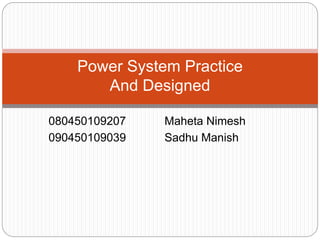
Determination of voltage regulation and power system losses
- 1. 080450109207 Maheta Nimesh 090450109039 Sadhu Manish Power System Practice And Designed
- 2. Voltage Regulation in power system All the equipments in the electrical network are designed to operate with a certain voltage range. Due to voltage drop occurring in every section of the system, the equipment which is farthest from the sub station would receives the lowest voltage. Generally, lower line voltage drop and line losses are desirable and a large conductor size should be used transmission of voltage for this purpose.
- 3. The voltage drop over the line is given by IZ, where Z=R + jX. The value of R reduces with increase in size of conductor but reactance X which is the function of spacing does not change with conductor size. The voltage regulation defines the concept of maintaining a relatively stable voltage level at the consumer’s end. There are three main assumptions for voltage regulation which are following :
- 4. a) The voltage variations must not be greater than certain established limits. b) The voltage must not be subjected to serious fluctuation or flicker. c) The voltage must approximate to some optimum level. Percentage voltage regulation for lagging power factor is given by
- 5. Where, i.e., sending end voltage = receiving end voltage + load voltage Percentage voltage regulation for leading power factor is given by where, = sending end line voltage = receiving end line voltage I = line current
- 6. R = line resistance X = line reactance cosΦ = power factor The methods of voltage regulations used on the distribution systems are 1) Transformer Taps ± % & ± 5 % 2) Auto control Induction type voltage regulators 3) Booster and Automatic tap changer 4) Capacitors
- 7. The transformer tap setting may be arranged in such away so as to maintain the voltage drop within 5%. The automatic voltage boosters are less expensive than induction one and they can improve service in low density areas on long rural lines. The boosters and automatic tap changers are installed on long distribution lines so as to regulate voltage on the feeders. The shunt capacitors are installed on the distribution system to reduce the current and to improve the voltage regulation and to reduce energy losses in every part of the system.
- 8. Power System Losses In electrical system, often the constant no load losses and the variable load are to be assessed alongside, over long reference duration, towards energy loss estimation. For example the cable losses in any industrial plant will be up to 6 % depending upon the size and complexity of the distribution system. Note that all of these are current dependent.
- 9. In system losses optimization, the various options available which are following: 1. Relocating transformer and substation near to load centers. 2. Power factor improvement by incorporating capacitors at load end. 3. Optimum loading for transformers in the system. 4. Minimizing losses due to weak lines in distribution network such as junipers, loose contacts, old brittle conductors. 5. Opting for lower resistance all aluminum alloy conductor in place of aluminum conductor steel reinforced lines.
- 10. Losses in component Various kinds of losses occur in our power system components such as the loss in step up transformers, transmission lines, primary distribution feeders, distribution transformers, distributors. In generators, two kinds of losses occur. One is loss which depends upon the loading condition and another iron loss is which only depends upon the operating voltage.
- 11. The total power loss does not depend upon the power factor. Therefore, the rating is always done in MVA. The rating of induction motor is always done in KW or MW.
- 12. Measurement of Losses A large number copper or aluminum conductors are used to form the transmission path. The resistance of the long distance transmission conductors is to be minimized. Capacitors are used to correct power factor by causing the current to lead voltage. Transformers are placed at strategic location throughout the system to minimize power losses in the transmission and distribution system.
- 13. We know, Efficiency = Where, Total power = useful power + power loss power loss = total power – useful power Or = 1 - = 1 - efficiency
- 14. Thank You
